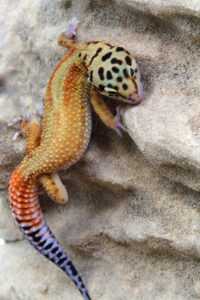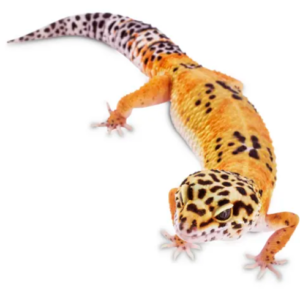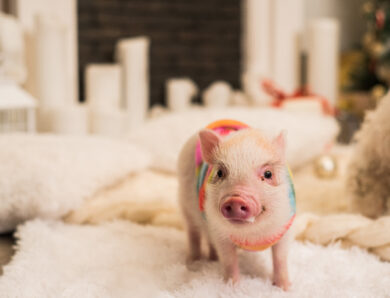
6 Surprising Leopard Gecko Facts
Leopard geckos are one of my favorite reptiles. With so many colors, beginner-level care, and upfront costs, it’s no surprise they’re one of the most-kept lizards. It’s easy to find information on how to care for leopard geckos, but there’s also a ton no one ever mentions.
From changing colors to climbing their enclosure walls, keep reading to learn six leopard gecko facts that might surprise you.
1. Leopard Geckos Can Change Their Look
While not nearly as dramatic as a chameleon, leopard geckos can and do change their appearance. Leopard geckos come in all different colors and patterns, known as morphs, and its these morphs that can change over time. If you get your leopard gecko as a baby or juvenile, you will most likely notice its pattern changing as it gets older.
With each shed, your leopard geckos’ pattern can change a little bit. Many have lots of spots or bands on their tails and these markings often soften as your gecko ages. This is because the larger it gets the less camouflage it would need in the wild. You won’t notice a dramatic difference, but over time it will change, and that’s perfectly normal.
2. Leopard Geckos Are Susceptible to Addiction

Here’s a leopard gecko fact we bet you didn’t know. Every wonder why experts insist on giving leopard geckos treats sparingly? Well, they can actually become addicted to treat foods, such as waxworms. And, in a quirk of leopard gecko behavior, if your gecko is addicted, he’ll skip meals in an attempt to force you to feed him what he wants.
The problem is that treats, like waxworms, don’t provide all the necessary nutrients for your pet gecko’s diet. Waxworms, in particular, are high in fat and can lead to an obese leopard gecko if fed too often.
It’s better to keep the treats to a minimum to avoid this problem.
3. They Don’t Like Other Leopard Geckos
Are leopard geckos social? The answer to that varies. With other leopard geckos, they are surprisingly territorial and don’t like sharing their space with other geckos. But with humans, they’re usually content with their owners and being handled.
Males, in particular, will fight if placed in the same cage. And, if you put a male and female in the same cage, she will likely become pregnant. Unless you’re planning on breeding them, I always recommend separate cages for multiple leopard geckos.
4. Your Leopard Gecko May Need a Bath.
This leopard gecko fact caught me off guard the first time I discovered it! No one ever told me I might have to give my leopard gecko a bath and yet last month that’s exactly what I found myself doing – bathing my leopard gecko for the first time.
Leopard geckos shed regularly, but it doesn’t always go smoothly, especially if the humidity in their cage isn’t right. Humidity affects how well your leopard gecko sheds, so you’ll need to make sure it’s set exactly right (between 40 and 60%), especially when it’s time to shed.
While most of their skin comes off without a problem (assuming the humidity is set just right), it’s still common for them to have trouble getting all the shed skin off their toes. Usually, you can rub it with your fingernails and it comes right off. But sometimes the skin is stuck, in which case, your little leopard gecko may need a bath.
It’s not complicated. All you need to do is put warm (not hot) water into a shallow dish so that your leopard gecko can submerge his feet into it. Keep him in there for a few minutes and you should be able to rub the shed skin off his toes easily.
5. Leopard Geckos Can Live a Long Time

Before getting a leopard gecko, make sure you’re ready to give it your all for its entire life, a life that is longer than you might expect. The lifespan of a leopard gecko can be anywhere from 10 to 20 years according to the RSPCA. That means that despite how cheap and easily available they are to buy, getting a leopard gecko requires a long-term commitment.
Though they are small and their enclosures don’t take up much space, they should receive the same level of care as any other pet in your home.
6. Leopard Geckos Are Good Climbers
Do leopard geckos climb?! I will never forget the first time I saw my leopard gecko climbing his enclosure. No one had ever mentioned to me that they’re good climbers, so it was a surprise to me.
Because leopard geckos don’t have the same toe pads that other geckos have, which let them climb nearly any surface, I just assumed mine couldn’t climb. But what they do have are skinnier fingers and toes with small nails on them. Nails that can help them dig into surfaces like wood and rock — or your Styrofoam background — to climb.
If you see your leopard gecko climbing, don’t worry too much. They should be able to get themselves down. If you don’t want your leopard gecko climbing or you’re worried he’ll hurt himself, you can easily remove your Styrofoam background or any hanging plants from his enclosure.
Now that you’re caught up on these surprising leopard gecko facts, find out why I believe leopard geckos are the best beginner reptiles.


